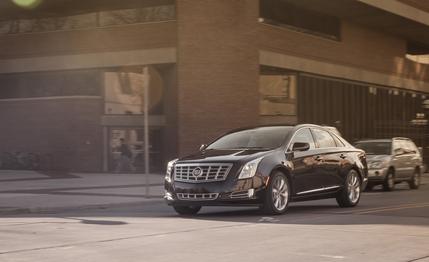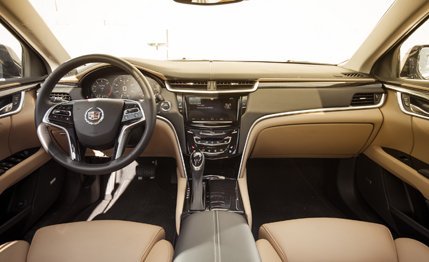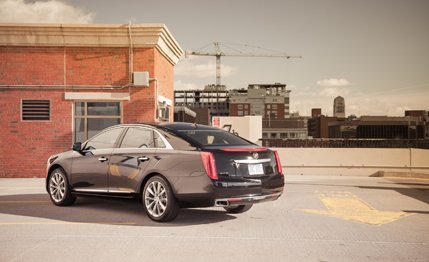
 Instrumented Test
Instrumented Test


Dead man walking, make way! Dead man walking! Actually, in the case of the 2013 Cadillac XTS sedan, it’s more like dead car, er, rolling. That’s because the XTS—it shares its bones with lesser GM sedans like the Buick LaCrosse and Chevrolet Impala—is expected to live for just a single generation. A proper Cadillac flagship riding on a new, premium rear-wheel-drive platform should eventually replace it. Why go through the effort of developing a car with a near-term death sentence? Seniors. The XTS positively drips with the geriatric-express stigma inherent in a V-6–powered, front-drive-based luxobarge, and that’s no bad thing for Cadillac’s bottom line. This car is intended to hold over DTS owners to finance Caddy’s eventual move to a BMW-like rear-drive-based car lineup.
We’ve already tested the all-wheel-drive XTS and pitted one against a Bentley Continental Flying Spur Speed (in a bang-for-buck-focused comparison test), but this is our first chance to strap our test gear to the front-wheel-drive model. So equipped, the XTS finds itself further conforming to the tastes of those who thought the (front-drive-only) DTS was for them. As a bonus, ditching the rear-end driveline gear saves some pounds—182, to be exact—plus some parts that take energy to move, improving fuel economy and saving buyers $2225 relative to AWD XTS Luxury, Premium, and Platinum models. A price-leader Standard trim level is available only in front-drive guise and runs $6840 less than the least-expensive AWD XTS.


A Little Stiff in Its Britches
The front-drive XTS’s driving experience is largely the same as the all-wheel-drive car’s, although the front-driver is noticeably quicker, taking just 6.6 seconds to reach 60 mph versus 7.2. As we’ve noted in other XTSs, the structure doesn’t feel as solid as one expects from a car in this price range. Harsh impacts can be heard and felt reverberating through the body, and it feels as though Cadillac hadn’t retuned the standard Magnetic Ride Control (MRC) magnetorheological dampers or the rear air suspension to account for the missing all-wheel-drive hardware. The ride is firm, and there’s little indication from your backside that the typically excellent MRC dampers are doing much to smooth out big road imperfections. On the upside, braking performance is impressive; we needed only 166 feet to halt the XTS from 70 mph.
The luxurious interior looks great and is a nice place to spend time—if you never need to change a radio station or adjust the climate-control setting. We covered the breadth of our complaints about Cadillac’s infuriatingly cumbersome, capacitive-touch-operated CUE system in our review of an all-wheel-drive XTS, but let us state again that it’s incredibly frustrating to use. We can only wonder how intimidating it is for Jitterbug-toting seniors to navigate. Outside, the XTS’s exterior styling is handsome and tasteful and wears its front-drive proportions well. It seems the rest of the preretirement-age public isn’t with us on this, though, and we failed to hear a single positive remark from anyone not eligible for social security.


Not Really a Flagship, but Actually Expensive
Which brings things back to the car’s upper-luxury appeal. The all-wheel-drive model could find fans in snowy northern states, but we’re not sure many folks besides former DTS customers will lust after this version. Its specifications (and those of its only true competitors, the front-drive Acura RLX and Lincoln MKS) read like those of a Toyota Avalon, Buick LaCrosse, Chevrolet Impala, or Hyundai Azera. Those cars offer similar drive layouts and levels of standard and optional equipment (minus the Caddy’s exotic MRC shocks, Brembo brakes, or air suspension) but carry base prices about $20,000 less than the $56,305 sticker price of our XTS Premium test vehicle. Even in base form, the Cadillac is still almost $45,000—a lot more scratch than for any of the aforementioned offerings, and more in line price-wise with rear-drive luxury sedans such as the Hyundai Genesis, Infiniti M37, and Lexus GS350.
Unless you need a black car, we’d suggest waiting for the rear-drive 2014 CTS sports sedan to hit dealerships or for the brand’s proper rear-drive flagship in a few years’ time. Next year, Caddy is adding a 420-hp twin-turbocharged V-6 to the all-wheel-drive XTS’s options sheet, which could make things interesting. Otherwise, the XTS’s same basic goodness can be had for far less money in the form of the 2014 Chevy Impala or Buick LaCrosse.